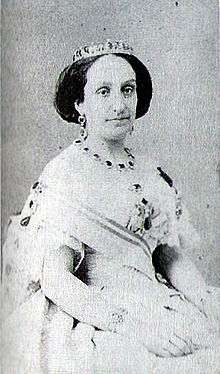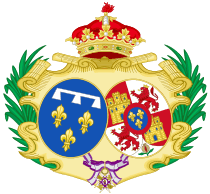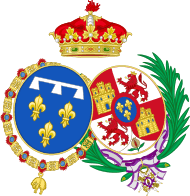Infanta Luisa Fernanda, Duchess of Montpensier
| Infanta Luisa Fernanda | |||||
|---|---|---|---|---|---|
| Duchess of Montpensier | |||||
 Infanta Luisa Fernanda | |||||
| Born |
30 January 1832 Royal Palace of Madrid, Spain | ||||
| Died |
2 February 1897 (aged 65) San Telmo Palace, Seville, Spain | ||||
| Burial |
2 February 1897 Infantes Pantheon, Royal Monastery of San Lorenzo de El Escorial, Spain | ||||
| Spouse | Prince Antoine, Duke of Montpensier | ||||
| Issue |
María Isabel, Countess of Paris Mercedes, Queen of Spain Infante Antonio, Duke of Galliera | ||||
| |||||
| House |
House of Bourbon (by birth) House of Orléans (by marriage) | ||||
| Father | Ferdinand VII, King of Spain | ||||
| Mother | Princess Maria Cristina of the Two Sicilies | ||||
| Religion | Roman Catholicism | ||||
| Signature |
| ||||
| Royal styles of Infanta Luisa Fernanda of Spain, Duchess of Montpensier | |
|---|---|
| Reference style | Her Royal Highness |
| Spoken style | Your Royal Highness |
| Alternative style | Ma'am |
Infanta María Luisa Fernanda of Spain, Duchess of Montpensier (30 January 1832 – 2 February 1897) was Infanta of Spain and Duchess of Montpensier. She was the youngest daughter of king Ferdinand VII of Spain and his fourth wife Maria Christina of the Two Sicilies, the queen-regent, who was also his niece.
Biography

Heiress-presumptive
When her elder sister Isabella II of Spain succeeded to the throne, Infanta Luisa Fernanda was heiress-presumptive to the crown between 1833 and 1851, when Isabella's oldest surviving daughter was born.
Marriage
Isabella had been engaged to their first cousin the Duke of Cádiz, who was known to be homosexual and rumored impotent. Their kinsman, the King of the French calculated that no children would be born from Isabella's marriage, and planned the crown of Spain to eventually devolve to his own grandchildren. For this purpose, Luisa Fernanda was engaged to the Duke of Montpensier, the youngest son of king Louis Philippe, who also was Luisa's mother's first cousin.
Luisa Fernanda, only 14 years old, and Antoine, 22, had their nuptials on 10 October 1846 as a double wedding with Isabella and Francis', and young Antoine was elevated to the rank of an Infante of Spain. The couple moved to Paris and later to Sevilla. The relationship between Isabella and her sister was tense, due to Antoine's conspiracies against the queen.[1]
Antoine's father was deposed in 1848. The same year, the then 16-year-old Luisa Fernanda gave birth to their first child, Maria Isabel. After Isabella was deposed, the family went to exile. Luisa returned to Sevilla years later, already widowed, where she died.[1] She is buried at Escorial.
Issue

Luisa Fernanda and Antoine had nine children, but only five reached adulthood.[2]
- Infanta Maria Isabel (1848–1919), who married her first cousin Philippe, comte de Paris (1838–94), the French claimant, and became known as Marie Isabelle, comtesse de Paris. She had several children, including Princess Louise of Orléans, the maternal grandmother of King Juan Carlos I.
- Infanta Maria Amelia (1851–70).
- Infanta Maria Cristina (1852–79). After her younger sister Mercedes died, she was engaged to Alfonso XII, five years her junior, but she died before the wedding.
- Infanta Maria de la Regla (1856–61).
- [?] (1857-1857).
- Infante Fernando (1859–73).
- Infanta Maria de las Mercedes (1860–78), otherwise Princess Marie des Graces d'Orleans-Montpensier, who married her first cousin Alfonso XII and is historically known as Mercedes of Orléans, Queen of Spain. No children.
- Infante Felipe Raimundo Maria (1862–64)
- Infante Antonio, Duke of Galliera (1866–1930), became Duke of Galliera in Italy. He married his first cousin Infanta Eulalia of Spain (1864–1958), daughter of Isabella II, and had two sons:
- Infante Alfonso (1886–1975), 5th Duke of Galliera (1930–37), who married Princess Beatrice of Saxe-Coburg and Gotha, daughter of Alfred, Duke of Saxe-Coburg and Gotha and had three sons, though only the oldest one left issue. General of the Spanish Air Force.
- Infante Luís (1888–1945), who married Marie Charlotte Say (1857–1943). No issue.
- Infante Luis Maria Felipe Antonio (1867–74)
Descendants
Of all her children, just Marie Isabelle de Paris and Antonio di Galliera left issue. Through Antonio, the now non-royal line of dukes of Galliera continues. Alfonso's grandchildren lost royal status because of non-dynastic marriages. The current Duke of Galliera is Alfonso's great-grandson, Don Alfonso Francesco de Orléans-Borbón y Ferarra-Pignatelli.[2]
Through Marie Isabelle, she became great-grandmother of king Manuel II of Portugal, Amedeo, Duke of Aosta, Aimone, Duke of Spoleto and Luis Filipe, Duke of Braganza; great-great-grandmother of Juan Carlos I of Spain and Henri, Count of Paris.
Candidate for the Ecuadorian throne
There are several documents, mostly diplomatic correspondence between Latin American embassies settled in London, in which the personal participation of the king Louis Philippe I is presumed in the plans to create a Kingdom of Ecuador traced by the former president Juan Jose Flores, because the French Government officially denied the support when those were presented in Paris some weeks before. For this, the King bring his own money in exchange for placing one of his descendants in the Ecuadorian throne.[3][4]
According to Francisco Michelena Rojas, Ecuador's ambassador in London, the plans to create a Kingdom of Ecuador traced by the former president of that South American country, General Juan Jose Flores, would have been echoed in the major European Courts with interests in America. Michelena mainly accused France of stirring in different ways to establish its domination, offering their princes under family alliances, or their protectorate, trying to influence governments against national interests and humiliating their novel nationalities. For this, the money needed for the expedtition probably coming from the king Louis Philippe I.[5]
In the other hand Manuel Moreno, Argentina's ambassador in London, also suspected the French intervention in Ecuador, believing that the candidacy to the throne offered to Agustín Muñoz of Bourbon-Two Sicilies, third child of the second marriage of the Queen Maria Christina of the Two Sicilies, was only apparent and provisional, and that basically everything was run by the French monarch to end with the other part of the Treaty of Utrecht, and bring the House of Orléans to Latin America. Moreno based his hypothesis on the strategic marriage between Antoine d'Orléans, Duke of Montpensier and the Spanish infanta Luisa Fernanda, for whose benefit would actually be the future monarchy their pretend to set up in America from Ecuador.[5][6]
Titles, styles, honours and arms
- 30 January 1832 – 10 October 1846: Her Royal Highness Infanta Luisa Fernanda of Spain
- 10 October 1846 – 4 February 1890: Her Royal Highness The Duchess of Montpensier
- 4 February 1890 – 2 February 1897: Her Royal Highness The Dowager Duchess of Montpensier
The Duchess's complete style, after her marriage, was: Su Alteza Real la Serenísma y Egregia Señora Infanta Doña Luisa Fernanda de Borbón y Borbón, Duquesa de Montpensier (in English: Her Royal Highness the Most Serene and Egregius Lady Infanta Doña Luisa Fernanda de Bourbon, Duchess of Montpensier).
Arms
| Heraldry of Infanta Luisa Fernanda of Spain, Duchess of Montpensier | ||||||||||
|---|---|---|---|---|---|---|---|---|---|---|
| ||||||||||
Ancestry
References
- 1 2 Archived November 2, 2005, at the Wayback Machine.
- 1 2 HRH Infanta Doña Luisa Fernanda and her descenants at the Wayback Machine (archived October 28, 2009)
- ↑ Vélez Ochoa, Ricardo (2006). The shipwrecked species (in Spanish). Bogotá: Javerian Pontifical University. p. 146.
- ↑ Van Aken, Mark. King of the Night: Juan José Flores and Ecuador 1824-1864. United States: University of California Press. p. 216. Retrieved April 18, 2015.
- 1 2 Orrego Penagos, Juan Luis. "The general Juan José Flores and Perú". Rumbo al Bicentenario. December 2003. Retrieved April 17, 2015.
- ↑ Cervera, César (May 19, 2015). "María Luisa Fernanda of Bourbon, the daughter of Fernando VII who wanted to reign in Ecuador and almost did in Spain" (in Spanish). Madrid. ABC.es. Retrieved July 11, 2015.


_as_Infanta_and_widow.svg.png)

_Version_with_Golden_Fleece_and_Order_of_Charles_III_Collars.svg.png)